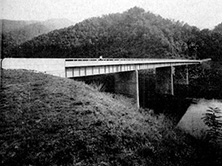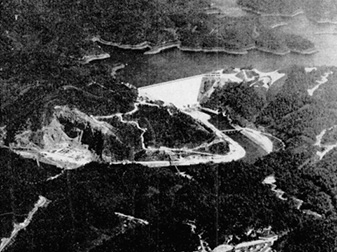 The award-winning Graham County Bridge 9 constructed by the Tennessee Valley Authority near the Fontana Dam in 1945 (TVA, The Fontana Project)
The award-winning Graham County Bridge 9 constructed by the Tennessee Valley Authority near the Fontana Dam in 1945 (TVA, The Fontana Project) The federal government took a number of direct and indirect actions in the early and mid-20th century that led to the construction of bridges in North Carolina on municipal, state and federal lands.
The Federal Aid Act of 1916 helped finance state construction of bridges. During the Great Depression, New Deal programs — particularly those of the Public Works Administration and Works Progress Administration — provided funds for hiring thousands of workers to build roads and bridges for state and municipal highway projects.
The Civilian Conservation Corps constructed thousands of bridges, most of which were simple, untreated timber structures. The CCC also erected a small number of notable, rustic, stone-faced bridges on federal lands, including the Great Smoky Mountains National Park in North Carolina and Tennessee. Through its construction of the Blue Ridge Parkway, the federal government directly designed and built many bridges in North Carolina and Virginia, employing local men and others through the CCC.
 The Tennessee Valley Authority Fontana Dam under construction in Graham and Swain counties, early 1940s (TVA, The Fontana Project) The Tennessee Valley Authority was another New Deal program that led to the construction of bridges on federal lands in North Carolina. The TVA, established in 1933, built dams and public works along the Tennessee River system, which drains parts of western North Carolina. It provided much-needed relief for the economically depressed region of southern Appalachia, while meeting its goals of improving flood control, navigation, soil conservation, recreation and, most importantly, electric power generation via large storage dams and reservoirs.
The Tennessee Valley Authority Fontana Dam under construction in Graham and Swain counties, early 1940s (TVA, The Fontana Project) The Tennessee Valley Authority was another New Deal program that led to the construction of bridges on federal lands in North Carolina. The TVA, established in 1933, built dams and public works along the Tennessee River system, which drains parts of western North Carolina. It provided much-needed relief for the economically depressed region of southern Appalachia, while meeting its goals of improving flood control, navigation, soil conservation, recreation and, most importantly, electric power generation via large storage dams and reservoirs.
The TVA relocated roads and bridges flooded by its reservoirs, and built some tee beam and steel-girder-and-floorbeam bridges with continuous-cantilever designs that were economical, but required advanced stress analysis. Among these continuous-cantilever designs is the structure that carries N.C. 28 over the Little Tennessee River near Fontana Dam (Graham County Bridge 9). Both the bridge and the Moderne-style dam were erected in 1945.
Although economics were an important consideration — it incorporated beams salvaged from the dam’s construction trestles — aesthetics were not ignored. Its clearly expressed function and a "simplicity of details” that gave it a “striking appearance” earned the bridge the American Institute of Steel Construction's award for most beautiful bridge in its class in 1945.